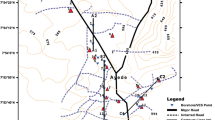Abstract
The Central Ground Water Board (CGWB) constructed 72 bore wells down to a targeted depth of 208 m in Nanded district, Maharashtra which is mainly underlain by hard rocks, namely basalts and granites. The yield of these bore wells varies from 0.10 litres/second (l/s) to 25 l/s and depth of weathering varies from less than 1 m to 24 meters below ground level (m bgl). The shallowest and the deepest aquifer zones are encountered at 7 and 172 m bgl respectively and majority of the productive aquifer zones are encountered within 100 meter (m) depth. Most productive zones are fractured basalts, fractured and weathered granites and 31 % of the zones are encountered within 25 m, 36 % within 25–50 m, 24 % within 50–100 m, 8 % within 100–150 m and less than 1 % within 150–173 m depth ranges. Out of the three major sets of lineaments, the NE-SW trending lineaments are more productive, and a maximum of five fracture zones are encountered in all. Surface geophysical studies (profiling) reveal that wherever the ratio between high resistivity and low resistivity is high, the discharge is high, and where the ratio is low the discharge is low. The depth to water level in these bore wells are in the range of 1.5–47.5 m bgl (below ground level). The transmissivity (T) and Storativity (S) values of 21 wells range from 3 to 593 m2/day and 6.5 × 10−6 to 7.32 × 10−2 respectively. The groundwater from the area is mostly of Ca-Na-HCO3-Cl, Ca-Na-HCO3, Ca-HCO3-Cl, Na-HCO3, Na-HCO3-Cl, Na-Cl, Ca-HCO3 types in the descending order of dominance and a few are found to be unsuitable for drinking. At a few sites, drilling down to the targeted depth of 200 m couldn’t be completed due to highly fractured nature of formations, hydraulic backpressure, occurrences of saturated intertrappean beds and high magnetic nature of formations.
Similar content being viewed by others
References
APHA (American Public Health Association) (1998) Standard Methods for the Characteristics of Water and Wastewater. 20th Edition, NW Washington, DC. 20005-2605, pp.10–161.
Back, W. (1966) Hydrochemical Facies and Groundwater Flow Patterns in Northern Part of Atlantic Coastal Plain. US. Geol. Survey Professional Paper 498-A, US Government Printing Office 1988 0-227-224.
Bhattacharya, P.K. and Patra, H.P. (1968) Direct Current Electrical Sounding. Amsterdam Elseveir.
Bureau of Indian Standards (BIS) (2003) Indian Standard Drinking Water Specifications IS 10500:1991, Edition 2.2 (2003-09), New Delhi.
Central Ground Water Board (CGWB) (1998) Ground Water Exploration in Maharashtra and Union Territory of Dadra Nagar Haveli., Ministry of Water Resources, Govt. of India, Nagpur, p294.
Central Ground Water Board (CGWB) (2012) Guidelines for Aquifer Mapping, Govt. of India, Faridabad, p8.
Govt. of Maharashtra (2005) Socio-economic Review and District Statistical abstract for 2002-03, Nanded District, Maharashtra State, pp1–59.
Handa, B.K. (1974) Technical Manual No.1. Methods of collection and analysis of water samples and interpretations of water sample analysis. Ministry of Agriculture, Govt. of India.
GSDA and CGWB (2005) Dynamic Ground Water Resources of Maharashtra as on March 2004. Report of Groundwater Surveys and Development Agency, Govt. of Maharashtra and Central Ground Water Board, Nagpur, p332.
Kelly, W.E. and Mares, S. (1993) Applied Geophysics in Hydrogeological and Engineering Practice (Amsterdam: Elsevier), pp.290.
Madhnure, P. and Subramanian, P.R. (1996) Effect of Kadam Fault System on the Yield of Bore wells in Parts of Yavatmal district, Maharashtra. Proc. of the symposium on Mineral and Groundwater Resources of Vidarbha, Nagpur, pp.243–248.
Madhnure, P. (2001) Ground Water Resources and Development Potential of Nanded district, Maharashtra State. Unpublished Report No. 1111/DIS/2001, CGWB, Nagpur, p105.
Madhnure, P. (2002) Urban Hydrogeology and impact of pollution on groundwater regime in Nanded-Waghala Municipal Corporation, Nanded district, Maharashtra. Unpub.Report, Central Ground Water Board, Nagpur, p.61.
Madhnure, P. (2003) Basic Data Report of Exploratory well drilled at Vishnupuri village, District Nanded. Un-published report No. 1235/BDR/2003, CGWB, Nagpur, p.16.
Madhnure, P. and Tambe, J. (2012) Assessment of Groundwater Pollution in the Vicinity of MIDC Industrial Complex, Nanded District, Maharashtra, India. Mem. Indian Soc. Appld. Geochem., pp.64–277.
Ozha, G.D. (1998) Deep Exploration for Ground Water in Hard Rock Areas of Maharashtra-Keys to Successful Operation. Proc. of the workshop on Ground Water Development Trend and Its Related Issues in Maharashtra State, Central Ground Water Board, Nagpur, pp1-4-1 to 1-4-18.
Parasinis, D.S. (1973) Principles of Applied Geophysics. Fifth Edition, Chapman and Hall, London.
Piper, A.M. (1940) A Graphical Procedure in the Geochemical Interpretation of WaterAnalysis.Amer. Geophys. Union Trans., v.25, pp.914–928.
Ramam, B.K. and Murthy, V.N. (1997) Geology of Andhra Pradesh. Geological Society of India, Bangalore, 245p.
Raychaudhary, J.K., Saxena, H.P., Sinha, A.K. and Sen, D. (1984) Deccan Trap Flows in Parts of Nanded and Yeotmal Districts Maharashtra. Proc.Symp. on Deccan Traps and Bauxite 1976. Geol. Surv. India, Spec. Publ. no.14, pp.6–8.
Sandberg, S.K., Slater, L.D. and Versteeg, R. (2002) An integrated geophysical investigation of the hydrogeology of an anisotropic unconfined aquifer. Jour. Hydrol., v.267, pp.227–243
Sonkamble, S., Chandra, S., Nagaiah, E., Dar, F.A., Somvanshi, V.K. and Ahmed, S (2013) Geophysical signatures resolving hydrogeological complexities over hard rock terrain — a study from Southern India. Arabian Jour. Geosci., DOI: 10.1007/s12517-013-0931-4
Author information
Authors and Affiliations
Rights and permissions
About this article
Cite this article
Madhnure, P. Groundwater exploration and drilling problems encountered in basaltic and granitic terrain of Nanded district, Maharashtra. J Geol Soc India 84, 341–351 (2014). https://doi.org/10.1007/s12594-014-0138-7
Published:
Issue Date:
DOI: https://doi.org/10.1007/s12594-014-0138-7




